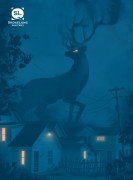The story is presented in sections. Each section delivers the reader to a different setting and a different time, while centering around the black-haired girl. What prompted you to structure the story in this way? Did you decide on this method prior to drafting the piece, or did it happen organically throughout your writing process?
The structure of this story happened organically. I didn’t initially have this story written in so many sections, but after several drafts I realized that I had narrative problem (lack of precision) and a structural problem (the story didn’t have much velocity). Once I stripped away other parts of the story and was left with just the most essential sections of the action, it started to work.
Your use of pronouns in this piece provides an element of ambiguity, which intensifies the haunting tone. Could you say more about the premise of the story? Specifically, how were you inspired to construct the character of the “girl,” and what does she work to symbolize?
The girl came to me in two parts. The visual of her came from an image in a dream I had two years ago. I’ve never been a person who deeply analyzes my dreams or keeps a dream journal, but for some reason this image really stayed with me and was something I don’t think my waking, more rational mind would have come up with. I kept the idea of her in the back of my head for a long time. Then in the year leading up to this story, I was thinking a lot about intimacy and how we have to negotiate the parts of our partners we don’t always want to acknowledge, especially in how it relates to their romantic past.
I think the girl symbolizes a number of things: the speaker’s jealousy as well as her humanity, the husband’s literal past, the girl’s own primality in addition to the speaker’s, and a connection to some sort of spiritual intensity, whether it’s death or something else. I like to think of the girl as open to a number of interpretations. She’s both a character and something more allegorical, which is one of the reasons I decided to keep the ambiguity the pronouns offered.
Much of the story is infused with poetic description. Do you read and write across multiple genres? I am curious both about your writing process for this story as well as your overall experience with genres outside of flash fiction.
Generally, when I start a fiction piece I have a set structure to begin with, a set of parameters or a couple structural moves that I tell myself I need to make happen. I use the parameters as a box I try to work my way out of. It’s a little mind game I play with myself in order to make the number of choices I have seem smaller than they actually are, and then the story takes on its own life and outgrows the structure I’ve imposed on it. I never start writing with an explicit plan of, I want the reader to understand “X idea” by the end.But I do start with the box as a way in, and then the writing process is attenuating myself to the capacities of the story, really listening to what it wants to become (in terms of the images and the voice), and once I understand that, revising relentlessly towards it. In this case, I wrote a bunch of drafts that didn’t work, but each one got me closer to understanding the speaker and her relationships. Then the last couple drafts were just revising with that intention in mind.
I love reading every genre. Right now, I’m reading Eavan Boland’s book of essays Object Lessons and Danez Smith’s poetry collection Don’t Call Us Dead. Last month I was really blown away by Tove Jansson’s The Summer Book. I like it all.
As far as writing in other genres,I try to write a little poetry as well. It requires a huge amount of precision, which is the best kind of challenge for me. Personally, I find writing poetry more difficult than fiction because poems leap seamlessly from idea to idea and image to image, while in fiction I feel more grounded because I know the mechanics of a story a bit better. I have more structural tools I can draw on when things aren’t lining up. But I get a lot from writing poetry! I’m going to keep working at it. It’s useful as well to have a lot of failed poems because even if the images don’t coalesce as a whole, the process of trying to make that happen always helps my fiction. I learn something new every time.
How many drafts of “Dark Little Spaces” did you compose? Is there anything significant that you edited out of the story?
This is probably the eighth draft of this story. There have been so many significant changes. I wrote and edited out several scenes—it was much more dramatic five drafts ago. There was a dead cat and a confrontation on a staircase. Only my sister read that draft! It makes me cringe even thinking about it. But I knew there was something good inside of all that, so I kept working. Little by little all the things that were inessential got stripped away, both in the narrative and the imagery. And by the end of that process, I had this draft.
What is the single best thing that has happened to you in the last month?
A delightful pair of clogs just came into my life in the color “pineapple.”



 The SmokeLong Grand Micro Contest (The Mikey) is now an annual competition celebrating and compensating the best micro fiction and nonfiction online.
The SmokeLong Grand Micro Contest (The Mikey) is now an annual competition celebrating and compensating the best micro fiction and nonfiction online.